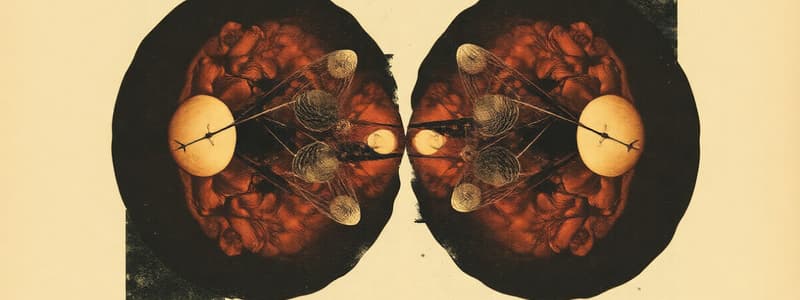Podcast
Questions and Answers
What is the role of non-kinetochore microtubules during cell division?
What is the role of non-kinetochore microtubules during cell division?
- They assist in chromosome alignment.
- They facilitate the formation of daughter nuclei.
- They help elongate the cell by pushing against each other. (correct)
- They create tension at the kinetochores.
Which of the following statements is true regarding telophase?
Which of the following statements is true regarding telophase?
- Genetically identical daughter nuclei form at opposite ends. (correct)
- Daughter nuclei are genetically different.
- Cytokinesis is completed during telophase.
- The spindle apparatus is fully intact during telophase.
When does cytokinesis typically begin in animal cells?
When does cytokinesis typically begin in animal cells?
- During metaphase.
- During anaphase or telophase. (correct)
- During early prophase.
- After cytokinesis has completed.
What process occurs in animal cells to complete cytokinesis?
What process occurs in animal cells to complete cytokinesis?
How do plant cells differ from animal cells during cytokinesis?
How do plant cells differ from animal cells during cytokinesis?
Flashcards
Non-kinetochore microtubules
Non-kinetochore microtubules
Microtubules that don't attach to chromosomes but overlap and push against each other, lengthening the cell.
Telophase nuclei
Telophase nuclei
Genetically identical daughter nuclei formed at opposite ends of the cell during telophase.
Cytokinesis start
Cytokinesis start
Cytokinesis begins during anaphase or telophase.
Animal cell cytokinesis
Animal cell cytokinesis
Signup and view all the flashcards
Plant cell cytokinesis
Plant cell cytokinesis
Signup and view all the flashcards
Study Notes
Cell Division: Telophase and Cytokinesis
- Non-kinetochore microtubules from opposite poles overlap, pushing against each other, lengthening the cell.
- In telophase, genetically identical daughter nuclei form at opposite cell ends.
- Cytokinesis starts during anaphase or telophase. The spindle eventually breaks down.
- In animal cells, cytokinesis involves cleavage, forming a cleavage furrow.
- Plant cells form a cell plate during cytokinesis.
Studying That Suits You
Use AI to generate personalized quizzes and flashcards to suit your learning preferences.




